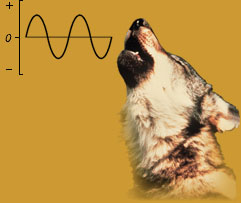
What’s in a Howl?
by Fred H. Harrington
Professor of Ethology
Mount Saint Vincent University, Nova Scotia
Ask anyone about wolf vocalizations and the howl invariably springs to mind. Even though wolves bark, woof, whine, whimper, yelp, growl, snarl and moan a lot more often than they howl, it is howling that defines the wolf, and fascinates us. So why do wolves howl?The center of a wolf’s universe is its pack, and howling is the glue that keeps the pack together. Some have speculated that howling strengthens the social bonds between packmates; the pack that howls together, stays together. That may be so, but chorus howls can also end with nasty quarrels between packmates. Some members, usually the lowest-ranking, may actually be “punished” for joining in the chorus. Whether howling together actually strengthens social bonds, or just reaffirms them, is unknown.We do know, however, that howling keeps packmates together, physically. Because wolves range over vast areas to find food, they are often separated from one another. Of all their calls, howling is the only one that works over great distances. Its low pitch and long duration are well suited for transmission in forest and across tundra, and unique features of each individual’s howl allow wolves to identify each other. Howling is a long distance contact and reunion call; separate a wolf from its pack, and very soon it will begin howling, and howling, and howling…
For the following examples of howling, you can “read” the sound spectrograph as you listen to the howls. For each spectrograph, the pitch of the sound is displayed on the vertical axis, so howls low in pitch are nearer the bottom, and howls high in pitch will be found toward the top. Time is represented along the horizontal axis, going from left to right, just as you are now reading this text. A howl that is unmodulated in pitch would appear as a straight line across the screen. Most howls show some degree of modulation, so they look like rolling hills or steep ridges leading to or falling away from plateaus. In addition to its so-called fundamental, or lowest frequency, most howls have harmonics, which appear as higher and higher bands of sound that run parallel to the fundamental on the sonagram.
You’ll need one of the free software plugins—RealPlayer orQuickTime to be able to view the sonagram clips of wolf howls below. If you already have the software, choose an appropriate connection speed (RealVideo) or the file size (QuickTime, AVI) to view a clip.NOVA Online | Wild Wolves | What’s in a Howl.
